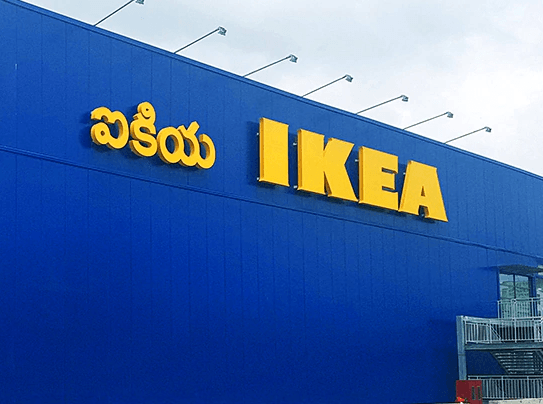On Thursday, the Swedish furniture retailer finally opened its first store in India, in Hyderabad. India, with a growing middle class, is a massive opportunity for the Swedish company. However, it is not an easy market to conquer, but IKEA India looks prepared.
IKEA India – why not before?
IKEA has invested about Rs 1,000 crore (about $150 million) in the store, which has a retail space of 400,000 sq ft and offers about 7,500 products. The 13-acre campus is located at the heart of the city, which is home to names like Microsoft, Google, Facebook and more. Over the next few years, IKEA India plans to open eight stores in the country, of which four will be in Hyderabad, Bengaluru, Mumbai and Gurugram.
The preparations by the Swedish company clearly suggest that it has taken its time to debut in India.
“The market of India for us is a dream,” company’s global chief executive Jesper Brodin said, according to BBC. “But to be honest, some years ago, when we looked into the business case of India, we felt it was too high risk from the cost perspective [of] not meeting our targets.”
A question that naturally arises is why not before? Government policies can be blamed for this. India allowed 100% FDI (foreign direct investment) in single-brand retail only in 2012. For the Swedish company, which does not prefer joint ventures, this sort of triggered a green light.
Also, the rapid growth of e-commerce in the country is another reason why the company sees the time of its debut suitable now. Though the company is working on expanding its physical presence, it has plans to start online sales as well by next year.
Changed its menu items
IKEA has done its homework, and knows well that to succeed in a country like India, it will have to change its approach, its offerings, its strategy and its style. Thus, it came as no surprise when on Thursday, its staff, wearing the usual company T-shirts, welcomed the crowd by waving India and Sweden flags.
What impressed the crowd even more was that they were greeted by a Gorkha rifles band of the Indian Army, which played the patriotic song “Saare jahan se achcha Hindustan hamara” (Our India is better than the rest).
Also, the company has changed its restaurant menu based on local feedback. Their signature pork and beef meatballs have been replaced with the vegetarian and chicken item. Moreover, the 1,000-seater restaurant offers a very affordable menu. “Ikea restaurant offers a variety of meals, including children’s options, vegetarian and Indian,” says its website.
Trimmed pricing with localized products
IKEA does look well prepared to meet the tastes of the buyers when it comes to food, but what about the products that it wants to sell in the country? The Swedish company has tailored its products for the local market, for instance, offering kitchen appliances to prepare the traditional rice cakes.
The company claims that it has visited about a thousand houses to understand what exactly Indian buyers want. In fact, the launch of IKEA’s first store in the country comes almost twelve years after the Swedish company started its research on the Indian market.
Further, pricing is always the most important decision when it comes to the Indian market. And, the Swedish company knows it very well. IKEA India plans to offer over 1000 products priced below Rs. 200 ($2.91). Experts, however, feel that the company needs to be careful as it will have to balance between setting prices low enough to attract price-conscious buyers and high enough not to discourage the status-conscious class.
Challenges still remain
IKEA India seems to have done well on the pricing and food front to attract potential buyers. However, the Indian market throws up more challenges for the Swedish company. For offering a true IKEA experience, the company needs huge tracts of land, something that is rare in most of the big Indian cities. If the land is available, it is massively expensive.
Another issue for the company is higher import duties. This may affect IKEA’s pricing strategy. If IKEA India decides to keep prices low, it could take longer to break even. Further, competition is yet another concern for the company. Though the majority of the furniture market is dominated by unorganized retail and local vendors, lately online furniture startups such as Pepperfry and UrbanLadder have become popular in big cities.
Around the world, IKEA is known for its ready-to-assemble products. But in India, thanks to the abundant supply of cheap labor, the “DIY” culture is almost non-existent, and people mostly rely on carpenters or ready-made products for their furniture needs. IKEA India is aware of this, and thus, it has partnered with UrbanClap, which is an online platform that connects buyers with service providers, including carpenters.
With all these challenges still open, it will be interesting to see how the Swedish company fares in the Indian market.





